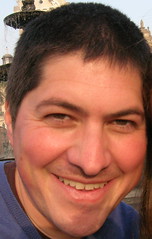7.25.2005
How do you say yummy in Quechua?
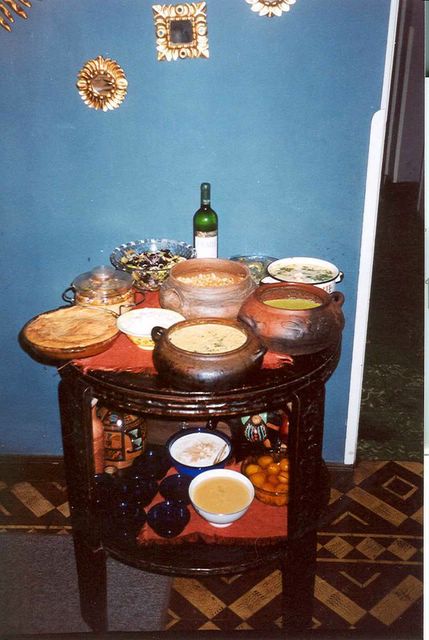
Chunka iskayniyoq sumaj Qosqo mijunakuna (12 exquisite dishes from Cusco). Photo by Noemí Vizcardo Rozas.
Noemí Vizcardo Rozas is a Quechua-speaking lawyer in Lima who runs a blog called hablaquechua (translation: Speak Quechua). Also known as Runasimi, Quechua is the native tongue of more than 8 million native people in Perú, Ecuador, Bolivia and Argentina.
Noemí's site is devoted to helping others learn the basics of Quechua language and culture. In a recent post, she described some of the traditional festival foods enjoyed by the people of Cusco during particular Catholic holy days in April and May.
Since we have a good number of Spanish-speaking readers here (read: I'm feeling a little bit lazy), I'll excerpt her description in its original Castellano.
- MISK'I (dulce) = Guisado o compota de duraznos, blanquillos, canela, azúcar rubia...
- MISK'I (dulce) = Arroz con leche pura de vaca, azúcar, pasas, coco rallado, canela en polvo...
- MISK'I (dulce) = Mazamorra de chancaca o remolacha, canela, leche, maizena, leche fresca...
- MISK'I (chocolate) = Cacao del valle de la Convención, canela, azúcar...
- MISK'I = empanadas dulces dornados con grajeas de colores arco iris.
- KACHIYOQ (salado) = Chupe de arroz, camarones, choclo, kaukau, habas, zanahorias,leche...
- KACHIYOQ (salado) = QOLLA LAWA( Espesado de choclo verde) ruda, huacatay, huevos...
- KACHIYOQ (salado) = MACRE CHUPI ( chupe de zapallo), kirku, pescado seco, verzas...
- KACHIYOQ (salado) = Salsa de qochayuyu, queso, habas, zanahorias, ají verde, aliño...
- KACHIYOQ (salado) Guiso de bacalao, garbanzos, aderezo español, perejil...
- KACHIYOQ (salado) Sudado de pescado, sebolla, tomate, limón, culantro, aderezo criollo...
- KACHIYOQ (salado) Pastel de choclo, queso, huevos, polvo de hornear, aceitunas...
Tags: Quechua, Cusco, Runasimi, Noemi Vizcardo Rozas, hablaquechua, Peru, Ecuador, Bolivia, Argentina, Spanish, Castellano
7.22.2005
Tannat, el sabor nacional de Uruguay

Barrels of Uruguayan Tannat, aging in the cellar of Bodega Juanico.
South American wines have made great headway in the United States. And for good reason. When it comes to price and quality, you really can't go wrong with a Chilean Cabernet or an Argentinean Malbec.
South America also harbors some rather eccentric wines that are fun to drink if only because of their colorful histories. Have you ever heard of Tannat? It's widely considered to be the national grape of Uruguay. Once grown exclusively in the Madiran region of southwest France, Tannat was brought to Uruguay by a French Basque immigrant, Pascal Harriague, in the 1870s. One devastating aphid plague and two world wars later, the grape is a footnote in European history. In Uruguay, however, it has become centerpiece of a small but intense wine industry, making up 25 percent of the country's vineyards.
This red grape varietal is named after its most prominent feature, a high tannin content. Tannins are what give red wines their structure and allow them to age well. The trade-off is that tannins also give young wines pucker power, a quality that in the extreme can render the wine undrinkable (and unsaleable) for several years. In Uruguay, they say that their Tannat is softer than the Tannat of Madiran, thus allowing them to create 100-percent Tannat wines that can be drunk young.
Tannat is not easy to find in the States. Uruguay ships only a tiny percentage of its production overseas. And bottles of Madiran represent a negligible portion of France's wine exports. But keep your eyes open. Some enthusiastic Tannat growers in Virginia (whose climate closely resembles Uruguay's) and California are petitioning the Feds to add the grape to the list of approved varietals. If that happens, a market could be born. Never say never. After all, five years ago, how many people knew about Pinot Noir?
Read more about Uruguay and Tannat at the 30-Second Wine Advisor.
Next wine post: Carmenere from Chile (have to go buy some first!)
Tags: Tannat, grapes, Uruguay, Pascal Harriague, Madiran, France, Argentina, Malbec, Chile, Cabernet, tannins, Virginia, California, Pinot Noir
7.21.2005
Mucha lucha

Professional wrestling in Bolivia. Photo by Noah Friedman-Rudovsky.
In the latest installment of El Alto Journal in the New York Times, Juan Forero describes the mayhem that is lucha libre, or professional wrestling. El Alto is a poor, indigenous district of 800,000 that overlooks La Paz. Here, professional wrestling looks nothing like we know it in Mexico or in the States. No spandex. No monster trucks. No lightshows. Not even a television camera. The show consists of bulked up Aymara and Quechua women pounding each other in the ring wearing traditional layered skirts and bowler hats.
I've always suspected that Andean women were tough, but this will make me think twice before haggling over the price of coca leaves in the mercado.
Read the full article (quick, before they archive it): In This Corner, in the Flouncy Skirt and Bowler Hat... or view the slideshow.
Tags: El Alto, Bolivia, La Paz, professional wrestling, Lucha Libre, Juan Forero, Aymara, Quechua, New York Times, Noah Friedman-Rodovsky
7.19.2005
Priceless view

For $60k, this could be the view off your porch every morning.
For sale: One recently-built mountain cottage in Sorata, Bolivia, just three hours (on a non-striking day) from LaPaz.
Asking price: US$63,000, negotiable.
Now, as Eduardo at Barrio Flores might attest, Bolivia is not in a happy place right now. But for 63 large one could almost afford to be wrong about the future of Bolivia.
I'd be first in line to snap up this place, but, sadly, blogging isn't the most lucrative business.

The owner (we presume) and his creation. Why is he selling?
Tags: Bolivia, Sorata, La Paz, property, for sale, mountain view
7.18.2005
Más fotos sublimes del Camino Inka
On the heels of the last post, I recalled that my blogging friend Rebecca had captured some excellent vistas along the Inka Trail earlier this year. I can't remember all the names of all the ruins anymore, so I'll just give my inner archaeologist a rest and let you enjoy the eye candy!
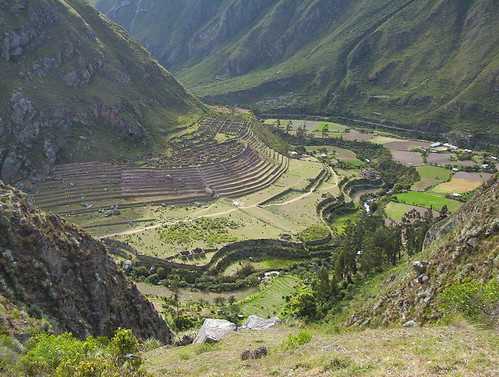
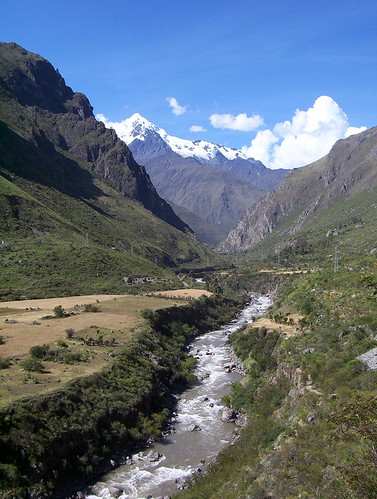
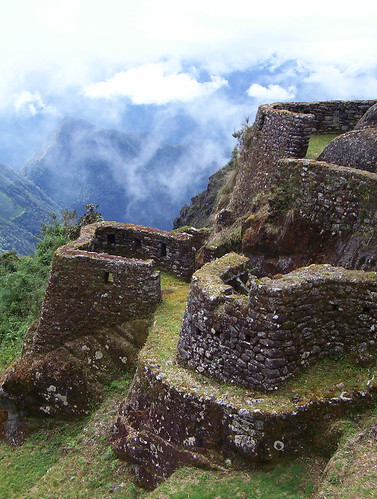
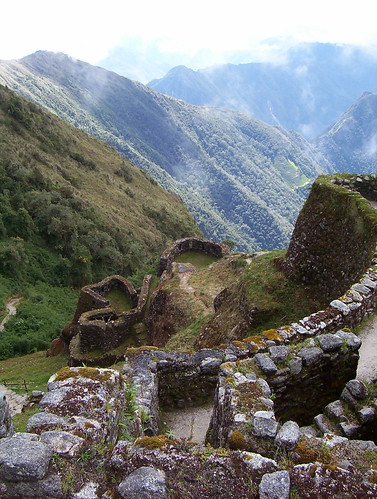
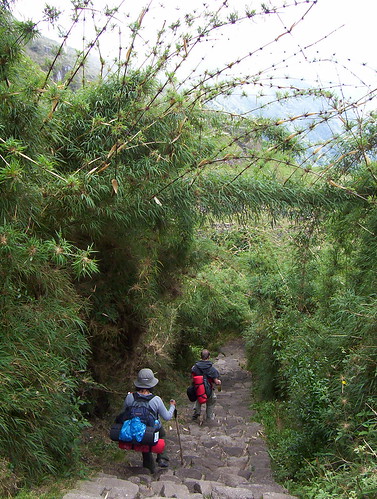
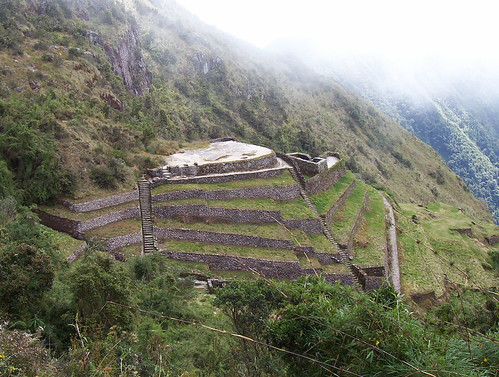
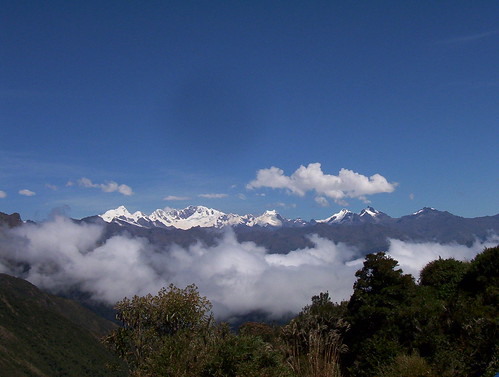
Photos by Rebecca Verner. Derechos muy reservados.
Tags: Peru, Inka Trail, Inca Trail, photos, Rebecca Verner, ruins







Photos by Rebecca Verner. Derechos muy reservados.
Tags: Peru, Inka Trail, Inca Trail, photos, Rebecca Verner, ruins
El Camino Inka
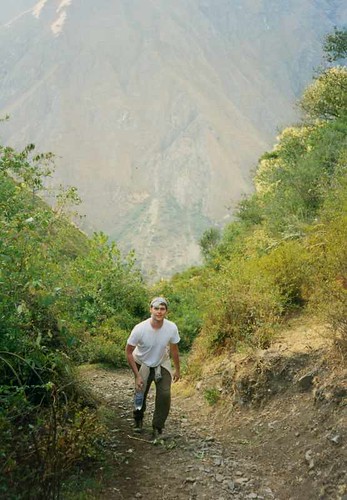
The climb.
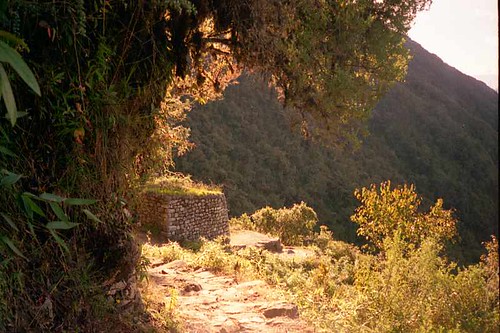
The sublime.
Hiking the Inka Trail is one of those experiences that's difficult to describe. On the one hand, sure, it's a hike on a high-altitude trail. It pretty much like four days of Stairmaster, eight if you take the long way. The trail rarely goes horizontally. As the Inkas seemed to view things, the fastest way between two points was a straight line. If that meant going straight up one mountainside and down another, so be it. And from what I've read by some Andean scholars, climbing and descending hundreds, if not thousands, of feet at a time is simply part of the Andean work ethic. It's not perceived as labor, so you'd never think of avoiding it. Incidentally, the Quechua word for stairs is the onomatopoeic "patapata."
But it's not the prospect of climbing non-stop for 10 hours a day that compels thousands of tourists to do the trail each year. It's something that Douglas Bernon captures perfectly in these lines from his article Reveries on A Walk to Machu Picchu:
"Depending on our altitude, we’ve been slipping up and down through a series of microclimates: cloud forest, grassy plains, high sierra, rain forest. Think orchids, jungles, and glaciers, all in the same picture. Once, much of Peru was laced with narrow Inca highways, wide enough only for a walker and his burdens. Many think the trail was a pilgrimage planned as a narrative experience, a complete work of art in which truths are revealed progressively in nature’s changing dramas, culminating with the mountaintop setting and elegantly crafted stone temples of Machu Picchu. Seems right to me."
Photos by Don Ball.
Tags: Peru, Inka Trail, Inca Trail, Douglas Bernon, Andes, Quechua, Machu Picchu, microclimate, nature
You are now entering...

The border of Perú and Ecuador at Tumbes. Photo by Dana Weniger & Andy Leach
7.14.2005
Guano wars
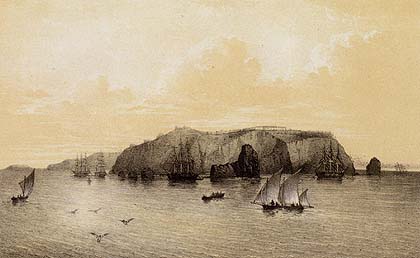
The Chincha Islands in 1864.
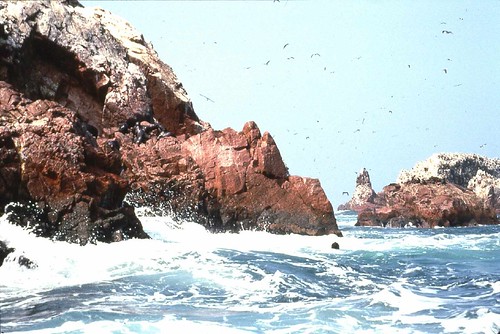
The nearby (and also guano laden) Islas Ballestas, off the coast of Perú. Photo by Don Ball.
Found this beaut in the South American Explorers Club e-newsletter today:
Toes!Fellow Peruvianists, please help me out. One thing I can't determine is whether the Chincha Islands are the same as the Ballestas. Were the Chinchas renamed at some point? Regardless, I would imagine that they are much the same -- chock full o' shitty birds.
That’s what a horrified Robert Murphy saw sticking up from the ground when he visited the Chincha islands at the height of the guano boom. These were the toes of the dead, their bodies thrown into shallow graves, all victims of the lucrative trade.
Fortunes were made in guano. The era between the 1840s and the 1890s was marked by a frenzy similar to that of America’s gold rush; to Peruvians, the commodity was tantamount to gold, and for good reason. One ton of guano is the equivalent of 33 tons of farmyard manure. Guano is also high in nitrates, a key ingredient in the manufacture of explosives. Guano’s virtues have been known since ancient times. The Inca put to death anyone who killed guano-yielding birds.
In the Chincha islands, guano had built up over centuries. On some islands, guano deposits were 22 feet thick. Guano deposits were estimated at 11 million tons, and by the 1840s, a brisk trade had developed. Income from guano accounted for a whopping 80 percent of Peru’s revenue. So valuable was guano for agriculture and weapons production that more powerful countries maneuvered to cash in. Spain occupied the islands in 1866, ending the Peruvian windfall.
To mine the guano, unscrupulous speculators brought in Chinese laborers and worked many to death. A typical worker moved up to four tons of guano a day. So appalling were the conditions that 60 Chinese committed suicide between 1852 and 1854. [Ed: Click here for an interesting story about a ship of coolies who mutanied rather than be brought to the Chinchas.] But the ruthless exploitation continued and exports skyrocketed—nearly one million tons in the 1860s. A war-hungry Europe guaranteed ever-increasing exports.
In fact, guano of such strategic importance that it led to the War of the Pacific, also known as Nitrate Wars. This four-year conflict proved disastrous for Peru. In the end, Chile occupied all Peru’s guano islands and even imposed a war indemnity upon the defeated nation to be paid for by guano revenues. Such harsh policies ensured that Peru not only lost revenue from sales, but also security for needed loans.
Today, guano mining is controlled by the Peruvian government, and exploitation of this resource is carefully controlled and regulated.
For those of you heading to South America or even contemplating a trip, I highly recommend joining the South American Explorers Club. Their irregularly published magazine alone is a worth the price of membership. Inside, you'll find a bizarre blend of wit, academia and hippy backpacker lore. To get a taste of club membership, you can sign up for the club's free e-newsletter.
7.12.2005
One day in Lima
A friend of mine is heading off to Lima today for a professional conference. She gets one free day before flying back to the states. So, I tried to give her some ideas -- based on my own limted experience -- of what to do if you have a short amount of time to experience the best of Lima.
If you think I missed anything, please leave a comment. That'll help me add to my list of new things to do next time. Also, keep in mind that this is a fairly touristy rundown. I'd never send someone who's not a diehard Peruanista to visit an interesting but truly dangerous neighborhood like Barrios Altos, as I did to Patrick Barr a couple months back.
So, on with the show!
If you could visit one church...
Monasterio de San Francisco, a block off the Plaza de Armas in the center of old Lima. The monastery, from 1621, I believe, has some fun catacombs and the church has the coolest old monastic library (behind the choir loft, I recall).
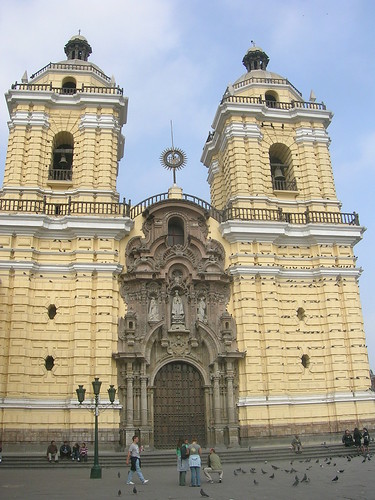
San Fransisco Church and Monastery, Lima. Photo by Andrea and Michael.
But I wouldn't be doing my duty if I didn't tell you about the Lima Cathedral, which is on the Plaza de Armas.
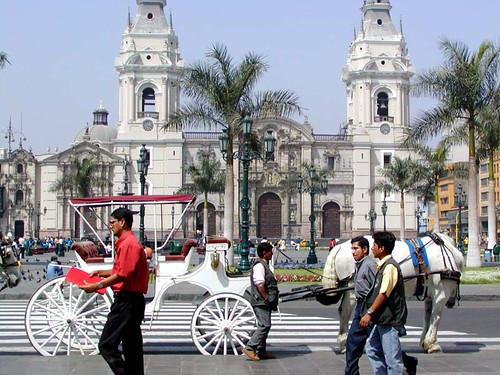
Plaza de Armas, with Cathedral of Lima in the background. Photo by Patrick Barry Barr
Also in the same district (behind the municipal palace) is a cool arcade...

Victorian-era shopping arcade, Lima
If you could go to one restauarant...
The Costa Verde is one of the nicer destinations in Lima, because it's right on the water (where there are literally no homes or businesses, other than two restaurants and tennis club) where I once had a turtle dish that left me speechless. The food consists of French influenced Peruvian dishes. The combination works well because Peru has great cold-water seafood in abundance, while the French sauces seem to make the most of the delicate flavors. Next runner up is La Rosa Nautica, just down the beach. Check out Fodor's review.
If you could go to one museum...
This one splits 4 ways, depending on your preferences:
Actually you could go to several in one night if you go to Barranco. This is where the old landed gentry built their homes in the 1700s and 1800s. There's one street that has all sorts of nightclubs. The best acts are Afro-Peruvian groups. However, if by chance you see that either Peru Negro or Susana Baca are playing anywhere in town, I'd highly recommend their shows.

Barranco by night.
If you could have one cocktail...
I'd be a traitor to my people if I didn't recommend a good Pisco Sour. They're generally better at the better restaurants and bars. Costa Verde (see above) just might have the best I've ever had.

If you could visit just one quaint neighborhood...
Again, Barranco is it. The area around the Puente de Suspiros (Bridge of Sighs - made famous in an old song) is fun to explore. Here's a picture of the bridge. Below it is a narrow street that winds between old houses and balconies down to the ocean. BTW, the pink church in the background is where my mom was baptized.
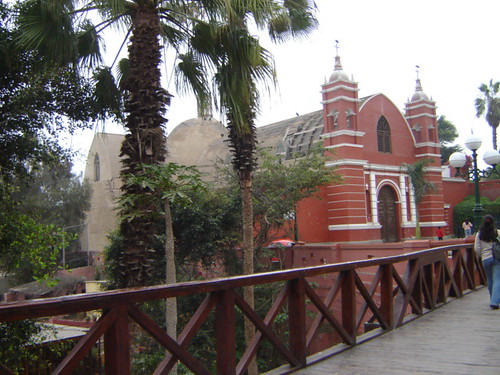
Puente de Suspiros, Barranco.
If you gotta shop...
Miraflores, the district you'll be staying in, has lots of shops. My favorite street is Avenida La Paz (just a block or two off the main square). They've got antique silver shops, jewelry shops and a few unique artists. Last time, I found this guy who did reproduction colonial paintings (in Cuzco School style) within hand-carved, faux-guilt frames. I got the piece below for just $300.
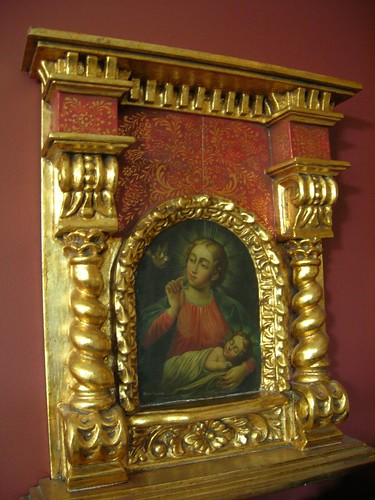
Found on Avenida Paz, Miraflores
If you go to one mall...
I actually enjoy going to Malls in other countries just to see how this American concept gets translated and transformed. In Miraflores is a place called Larco Mar. It's an open-air mall that overlooks the ocean a couple hundred feet below. It has some familiar stores, a Hard Rock Cafe, a Tony Roma's (go figure) and some specialty shops. Last time I was there, I enjoyed the espresso shop, which has great views from the window tables!

View of Larco Mar mall and coastline below. Photo by Guillebe
If you want to eat something really local (and safe)
Even though people in Lima will tell you about Cebiche (lime/onion/garlic/pepper marinated fish), I'd send you in the direction of Pollo a la Braza. It's essentially rotisserie chicken, usually served with fries of some sort. It must be the spicy marinade that makes it so good, but I've never had better, even though I generally just about any chicken on a spit. There is one place at Larco Mar (see above), called Pardo's Chicken. I know it's a pretty prominent chain.
If your sweet tooth strikes...
Don't know if you'll run into it, but there is a dessert called Picarones (Peek-a-RONE-es), which are essentially donuts, but made with sweet potato and pumpkin flour, with a sugar cane syrup over the top. Outrageously good. For some reason, they're typically served at places that make Anticuchos -- spicy marinated skewers of beef heart or beef.
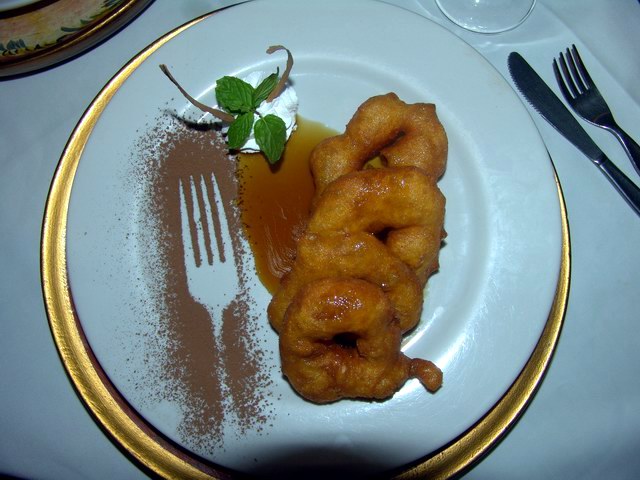
Picarones in syrup.
Dessert-wise, you might also try a pastry called Alfajores, which is essentially two shortbread cookies with manjar blanco (dulce de leche) filling, with a dusting of powdered sugar. Simple, ages old, and really good with an espresso.
If you want to see exotic ingredients...
If you had time, you'd certainly want to check out a more traditional market. Otherwise, visit a grocery store, where everything's in one place. It's great fun to look through the produce and meat sections, where there's much you won't recognize. And what you do recognize (corn, potatoes, beans) will be in more varieties than you thought possible. If you want something fun to bring back, there's a pepper called Ají Panca, which is available in powdered form in envelopes or in liquified form in jars. It's cheap -- and an incredible substitute for paprika.

Ají panca, pepper of the gods.
If you try just one ice cream...
Lucuma (LUKE-ooh-mah) is available at the D'Onofrio shop off the main square in Miraflores, or at any other ice cream shop in Lima. The flavor is caramel-like, somewhere between maple and prunes.

Helado de lucuma.
If you think I missed anything, please leave a comment. That'll help me add to my list of new things to do next time. Also, keep in mind that this is a fairly touristy rundown. I'd never send someone who's not a diehard Peruanista to visit an interesting but truly dangerous neighborhood like Barrios Altos, as I did to Patrick Barr a couple months back.
So, on with the show!
If you could visit one church...
Monasterio de San Francisco, a block off the Plaza de Armas in the center of old Lima. The monastery, from 1621, I believe, has some fun catacombs and the church has the coolest old monastic library (behind the choir loft, I recall).

San Fransisco Church and Monastery, Lima. Photo by Andrea and Michael.
But I wouldn't be doing my duty if I didn't tell you about the Lima Cathedral, which is on the Plaza de Armas.

Plaza de Armas, with Cathedral of Lima in the background. Photo by Patrick Barry Barr
Also in the same district (behind the municipal palace) is a cool arcade...

Victorian-era shopping arcade, Lima
If you could go to one restauarant...
The Costa Verde is one of the nicer destinations in Lima, because it's right on the water (where there are literally no homes or businesses, other than two restaurants and tennis club) where I once had a turtle dish that left me speechless. The food consists of French influenced Peruvian dishes. The combination works well because Peru has great cold-water seafood in abundance, while the French sauces seem to make the most of the delicate flavors. Next runner up is La Rosa Nautica, just down the beach. Check out Fodor's review.
If you could go to one museum...
This one splits 4 ways, depending on your preferences:
- If you like tapestries and fabrics...Museo Amano (in Miraflores, I believe) is a Japanese owned museum with arguably the best collection of Pre-Colombian textiles in the world, including a teeny, 1000-plus-year-old bit of cloth that's on record as the world's densest piece of fabric.
- If you like torture and sadism, the Museum of the Inquisition (Museo de la Inquisicion), in old Lima, is short, quick and fun.
- If you want a broad overview of Pre-Colombian and Colonial history, Museo Antropológico, in Pueblo Libre, is your best bet. The museum has lots of artefacts and then a section that's an old colonial plantation mansion, where there's lots of artefacts from the late 1500s, early 1600s, when this suburb was filled with nothing but farm fields and pre-inca pyramids.

Museo Antropológico, Pueblo Libre
- Finally, this one's a fave, because you get to walk among shelves containing thousands of ancient pottery pieces, as if you were an archeologist doing off-season research: Museo Rafael Larco Herrera, in Pueblo Libre. They also have an X-rated room, with all sorts of bawdy pots. I used to get a big kick out of that as a kid! Ahem. Not anymore.

Museo Rafael Larco Herrera, Pueblo Libre
Actually you could go to several in one night if you go to Barranco. This is where the old landed gentry built their homes in the 1700s and 1800s. There's one street that has all sorts of nightclubs. The best acts are Afro-Peruvian groups. However, if by chance you see that either Peru Negro or Susana Baca are playing anywhere in town, I'd highly recommend their shows.

Barranco by night.
If you could have one cocktail...
I'd be a traitor to my people if I didn't recommend a good Pisco Sour. They're generally better at the better restaurants and bars. Costa Verde (see above) just might have the best I've ever had.

If you could visit just one quaint neighborhood...
Again, Barranco is it. The area around the Puente de Suspiros (Bridge of Sighs - made famous in an old song) is fun to explore. Here's a picture of the bridge. Below it is a narrow street that winds between old houses and balconies down to the ocean. BTW, the pink church in the background is where my mom was baptized.

Puente de Suspiros, Barranco.
If you gotta shop...
Miraflores, the district you'll be staying in, has lots of shops. My favorite street is Avenida La Paz (just a block or two off the main square). They've got antique silver shops, jewelry shops and a few unique artists. Last time, I found this guy who did reproduction colonial paintings (in Cuzco School style) within hand-carved, faux-guilt frames. I got the piece below for just $300.

Found on Avenida Paz, Miraflores
If you go to one mall...
I actually enjoy going to Malls in other countries just to see how this American concept gets translated and transformed. In Miraflores is a place called Larco Mar. It's an open-air mall that overlooks the ocean a couple hundred feet below. It has some familiar stores, a Hard Rock Cafe, a Tony Roma's (go figure) and some specialty shops. Last time I was there, I enjoyed the espresso shop, which has great views from the window tables!

View of Larco Mar mall and coastline below. Photo by Guillebe
If you want to eat something really local (and safe)
Even though people in Lima will tell you about Cebiche (lime/onion/garlic/pepper marinated fish), I'd send you in the direction of Pollo a la Braza. It's essentially rotisserie chicken, usually served with fries of some sort. It must be the spicy marinade that makes it so good, but I've never had better, even though I generally just about any chicken on a spit. There is one place at Larco Mar (see above), called Pardo's Chicken. I know it's a pretty prominent chain.
If your sweet tooth strikes...
Don't know if you'll run into it, but there is a dessert called Picarones (Peek-a-RONE-es), which are essentially donuts, but made with sweet potato and pumpkin flour, with a sugar cane syrup over the top. Outrageously good. For some reason, they're typically served at places that make Anticuchos -- spicy marinated skewers of beef heart or beef.

Picarones in syrup.
Dessert-wise, you might also try a pastry called Alfajores, which is essentially two shortbread cookies with manjar blanco (dulce de leche) filling, with a dusting of powdered sugar. Simple, ages old, and really good with an espresso.
If you want to see exotic ingredients...
If you had time, you'd certainly want to check out a more traditional market. Otherwise, visit a grocery store, where everything's in one place. It's great fun to look through the produce and meat sections, where there's much you won't recognize. And what you do recognize (corn, potatoes, beans) will be in more varieties than you thought possible. If you want something fun to bring back, there's a pepper called Ají Panca, which is available in powdered form in envelopes or in liquified form in jars. It's cheap -- and an incredible substitute for paprika.

Ají panca, pepper of the gods.
If you try just one ice cream...
Lucuma (LUKE-ooh-mah) is available at the D'Onofrio shop off the main square in Miraflores, or at any other ice cream shop in Lima. The flavor is caramel-like, somewhere between maple and prunes.

Helado de lucuma.
7.07.2005
A place I wouldn't mind visiting...

"Cotopaxi" by Frederic Church, 1855. The buildings in the lower right presumably belong to Hacienda San Agustín de Callo.
From an archaeology standpoint, Ecuador sure got the raw end of the deal. As the second Inca capital, Quito must have boasted some splendid buildings. But there's no trace of them today. Ecuador's most famous ruins, Ingapirca, are nothing more than stone foundations, a sad joke compared to what has survived further south in Perú.
But there is one little gem of a ruin at the foot of the Cotopaxi volcano in the central part of the country. Hacienda San Agustín de Callo, as it's been called for the last few hundred years, was originally the site of an Inca temple and palace complex, built by Huayna Cápac around 1440.
Today, it's a hotel, nice (and expensive) by Ecuadorean standards. Run by Mignon Plaza, a descendant of the rich general who bought the place in the 20s, the hotel hosts both tourists and local Quichua Indians, who come to the former Inca palace to celebrate religious holidays, such as Inti Raymi.

Sleep like an Inca emperor in rooms that feature original Inca stonework.

Incur the wrath of Viracocha by dining in the only standing Inca temple in Ecuador.
7.01.2005
The urbane sprawl of Buenos Aires
Mega cities abound in South America. But few of them are as big and beautiful as Buenos Aires, Argentina. Many first-time visitors will express surprise at the city's strong European feel. It's no surprise, really. Millions of Spanish and Italian immigrants settled there through the late 1800s and early 1900s. And during those boom years, when Buenos Aires was the largest and probably the wealthiest city on the continent, the Porteños (that's what folks from B.A. call themselves) built grand edifices in a decidedly Parisian architectural style.
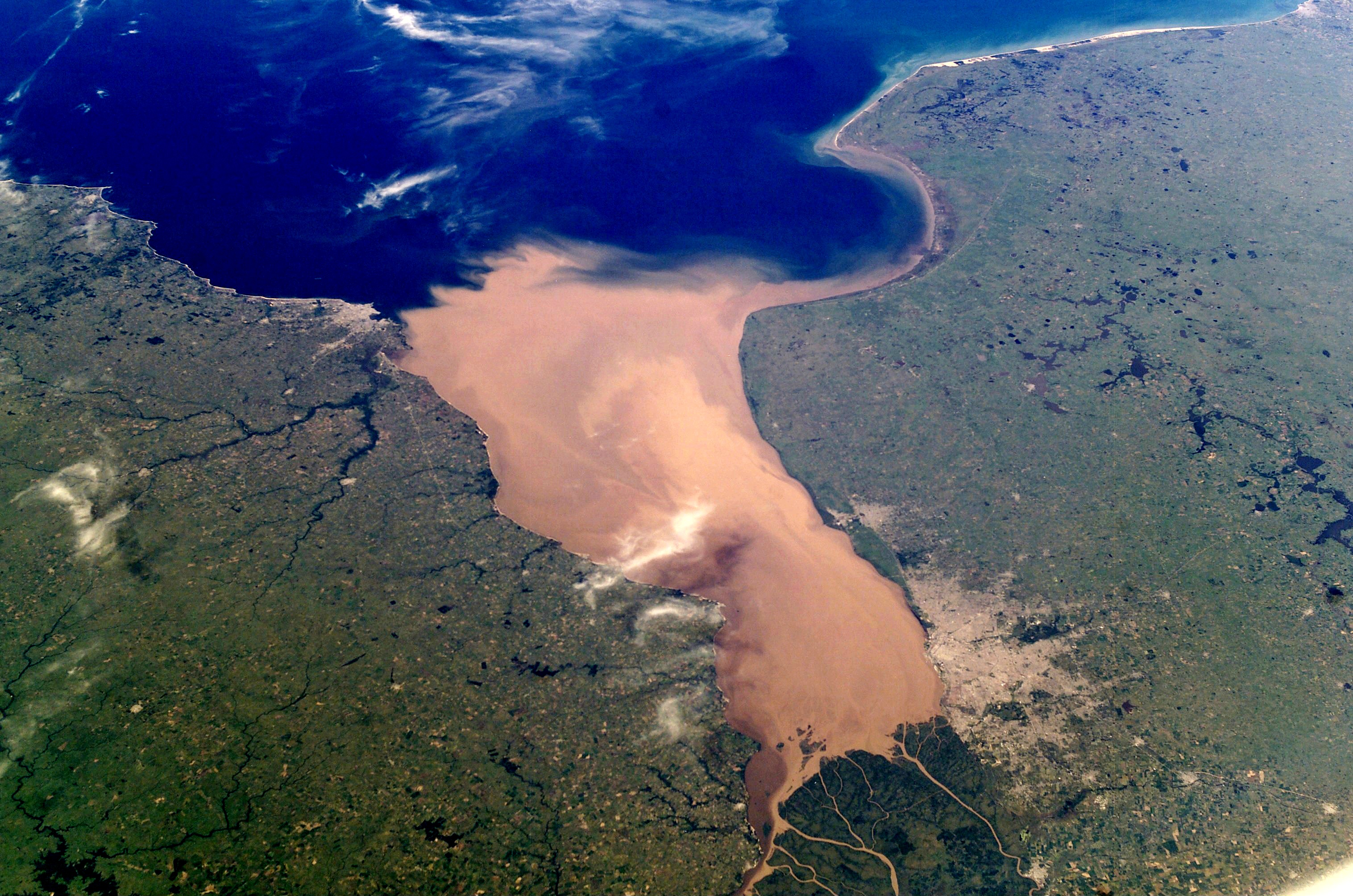
Buenos Aires and its 12.5 million inhabitants (lower right), as viewed from space. Buenos Aires sits along the the Río de la Plata. NASA photo.

A view of B.A.'s ubiquitous European-style architecture. Photo by Robert Wright.

A view of modern B.A.
Buenos Aires and its 12.5 million inhabitants (lower right), as viewed from space. Buenos Aires sits along the the Río de la Plata. NASA photo.

A view of B.A.'s ubiquitous European-style architecture. Photo by Robert Wright.

A view of modern B.A.

